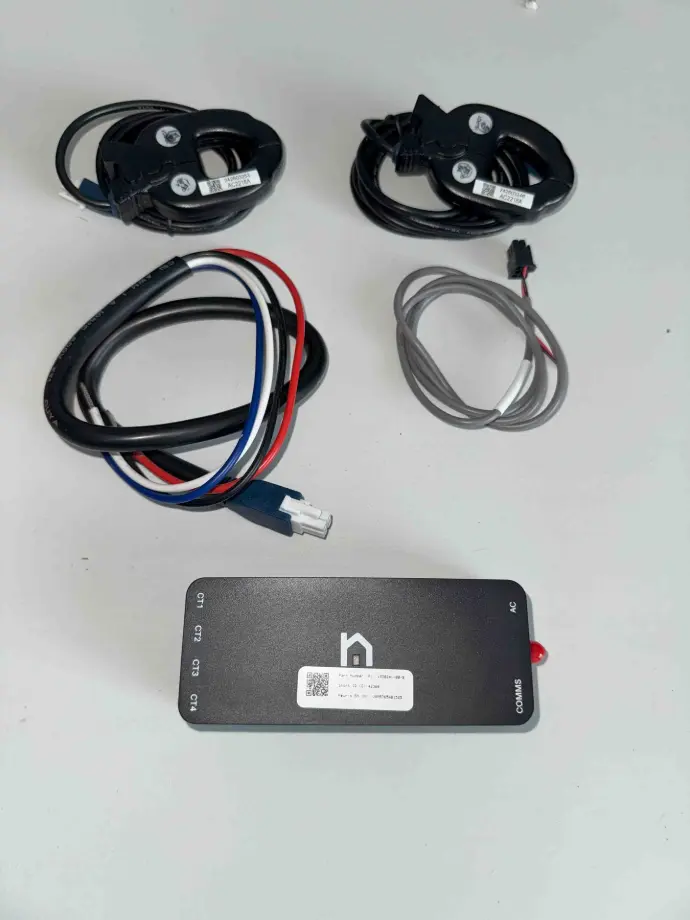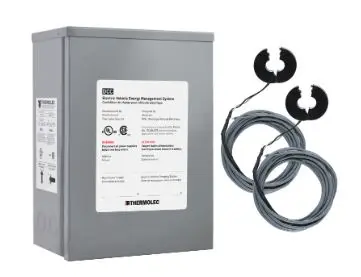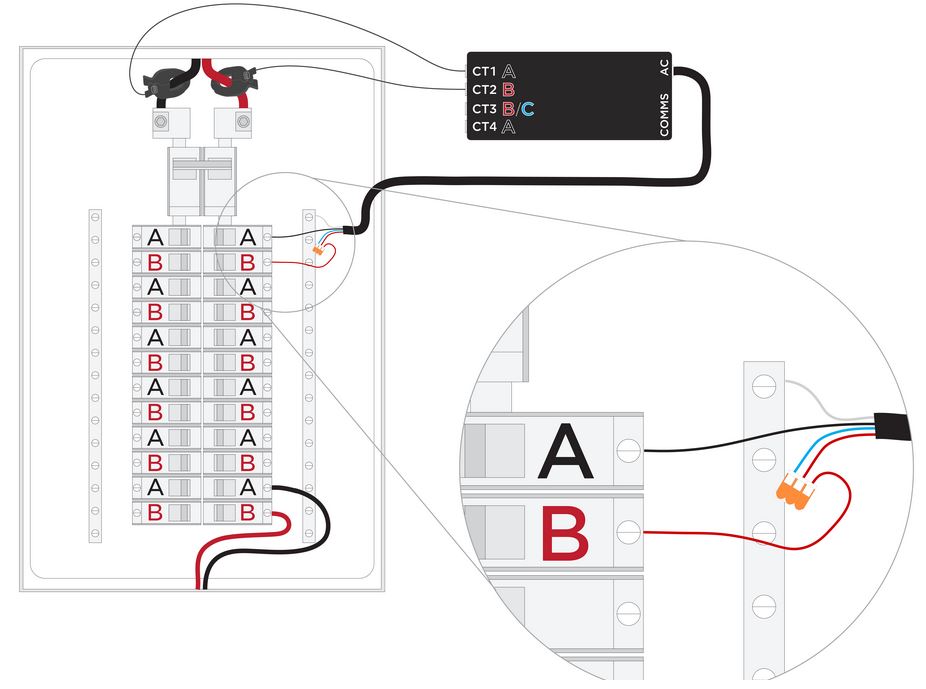Tesla's EVEMS solution
A separate add-on kit is used to monitor site power consumption and adjust the power output to your EV charger to prevent overloading the electrical panel.
The Neurio W2 Kit
The Tesla Wall Connector EV charger has dynamic power management capabilities that can be enabled by installing a 3rd party hardware kit. Enter the Neurio W2 energy meter kit: it includes 2 sensors for monitoring line current, power and communication cables, and a small control unit for monitoring sensor data and communicating to the Tesla Wall Connector.

Why use dynamic power management?
Not all existing homes have enough electrical capacity to accommodate a level 2 EV charger. Many existing residences have a 100 Amp electrical panel, and most level 2 EV chargers can output up to 48 Amps (11.5 kW) which is effectively 50% of the total available power.
This means that when performing a load calculation on a 100 Amp panel, there is insufficient remaining electrical capacity to accommodate a level 2 EV charger. In this scenario an EV charger can not be installed without violating electrical code rules.
Historically the solution to this problem is to either upgrade the electrical service ($$$), or use a DCC type system to provide "load shedding". The DCC load shedding systems will monitor the incoming power usage, and simply turn the EV charger off when there is insufficient power available to use it.

DCC- 12 system
While the DCC devices do solve the problem of providing a means of connection from an electrical panel that is at full capacity, it is not the most ideal solution. When the DCC system detects that the total power consumption of the electrical panel is greater than 80% of capacity, it will simply disconnect the EV charger by completely removing power to it. Effectively the EV charger can function at 100% output or not at all.
Dynamic power management is a superior solution than load shedding, in that the EV charger will simply adjust its output power from the charger to the vehicle when the overall power consumption for the site approaches the maximum limit. The EV charger will continually adjust its output between 0-100% of the maximum power configured for the unit depending on the other electrical loads connected to the panel.
Dynamic power management systems are generally smarter, cheaper and more effective than load shedding systems. The installation complexity for the dynamic power measurement systems is also reduced, resulting in a lower overall EV charger installation cost. When this type of EVEMS system is used it does not affect the load calculation of the electrical panel, and it is permissible to install a level 2 EV charger when it would otherwise not be.
Wall Connector and Neurio W2 meter
Connecting and configuring the two devices for dynamic power management
To provide dynamic power management for the Tesla Wall Connector, a Neurio W2 meter is installed at or near the electrical panel. The Neurio power cable (included in the kit) has lead wires to connect to the L1 and L2 power phases, as well as a wire to connect to the neutral bar.
There are also 2x current transformers that are clipped onto the incoming power wires (before the main breaker). These sensors output a signal proportionate to the amount of electrical current flowing though the wires to which they are connected.
The Neurio control unit measures the amount of power consumed via the current transformers, and sends the information to the Tesla Wall Connector via a 2-wire communication cable that is wired between the Neurio control unit and the Wall Connector.
Neurio W2 meter configuration and use
Configure using a smart phone
The Neurio W2 configuration is performed using the Tesla One app on a smart phone or tablet. After installing and connecting the Neurio and the Tesla Wall Connector, the user can access the Wall Connector configuration by connecting to the charger's on-board Wi-Fi and using the Tesla One app. If the Neurio device is powered and the communication cable is correctly installed, the meter will be detected automatically.
The next step in the system configuration is to specify the maximum allowable current draw for both the Tesla Wall Connector and the conductors that supply power to the electrical panel. For the test setup both parameters were set to 24 Amps to make it easier to exceed this threshold while testing and observe the power output fluctuation from the charger.
With the charger plugged into the vehicle, a charging session was initialized and the output was observed. At a 24 Amp max output setting, 5.7 kW is the expected maximum output from the Tesla Wall Connector.
Our test began while having several appliances active to increase the overall power draw at the electrical panel, and ensure that the Tesla Wall Connector had a reduced power output:

Next we turned several other devices on and off to view the output power modulation from the charger:






Finally, the appliances were all turned of to reach the peak charging output:

Following the testing, the proper settings were configured for the Tesla Wall Connector for the real-world requirement of charging at 48 Amps from a 100 Amp electrical service:
Final Thoughts
Dynamic power management is a fantastic technology that makes it possible to install a high output level 2 EV charger on electrical infrastructure that would otherwise be overloaded based on standard calculations. These systems are often smarter, cheaper, and easier to install than a typical DCC load shedding system.
An expensive service upgrade can be avoided by using a dynamic power management system and these systems are paramount for widespread EV charging infrastructure adoption.



